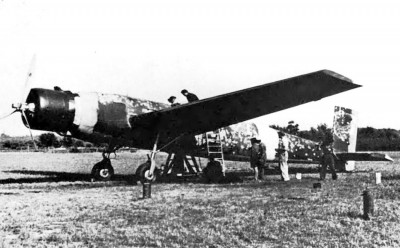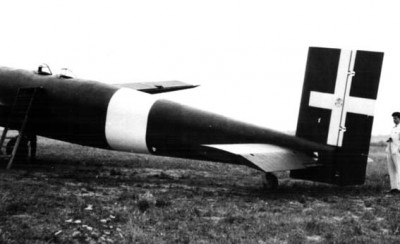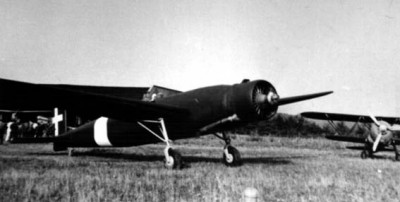| Název: Name: | Aeronautica Lombarda AR | Aeronautica Lombarda AR |
| Originální název: Original Name: | Aeronautica Lombarda AR | |
| Kategorie: Category: | vyčkávací munice | loitering munition |
| Výrobce: Producer: | DD.MM.1943-DD.MM.1943 Aeronautica Lombarda SA, Cantu | |
| Období výroby: Production Period: | DD.MM.1943-DD.MM.1943 | |
| Vyrobeno kusů: Number of Produced: | 2 | |
| První vzlet: Maiden Flight: | 13.06.1943 | |
| Základní charakteristika: Basic Characteristics: | ||
| Vzlet a přistání: Take-off and Landing: | CTOL - konvenční vzlet a přistání | CTOL - conventional take-off and landing |
| Uspořádání křídla: Arrangement of Wing: | jednoplošník | monoplane |
| Uspořádání letounu: Aircraft Concept: | klasické | conventional |
| Podvozek: Undercarriage: | odhazovací | jettisonable |
| Přistávací zařízení: Landing Gear: | kola | wheels |
| Technické údaje: Technical Data: | ||
| Hmotnost prázdného letounu: Empty Weight: | 3600 kg | 7937 lb |
| Maximální vzletová hmotnost: Maximum Take-off Weight: | 6000 kg | 13228 lb |
| Rozpětí: Wingspan: | 17,00 m | 55 ft 9 ¼ in |
| Délka: Length: | 14,00 m | 45 ft 11 ⅛ in |
| Výška: Height: | 3,40 m | 11 ft 1 ⅞ in |
| Plocha křídla: Wing Area: | 38,00 m2 | 409.03 ft2 |
| Pohon: Propulsion: | ||
| Kategorie: Category: | pístový | piston |
| Počet motorů: Number of engines: | 1 | |
| Typ: Type: | Fiat A-80 RC-41 o výkonu 734 kW/1000 k | Fiat A-80 RC-41, power 984 hp |
| Objem palivových nádrží: Fuel Tank Capacity: | ? | ? |
| Výkony: Performance: | ||
| Maximální rychlost: Maximum Speed: | 360 km/h v ? m | 224 mph in ? ft |
| Cestovní rychlost: Cruise Speed: | 280 km/h v ? m | 174 mph in ? ft |
| Operační dostup: Service Ceiling: | ? m | ? ft |
| Maximální dolet: Maximum Range: | 600 km | 373 mi |
| Vytrvalost: Endurance: | ? h | |
| Výzbroj: Armament: | 2x 1000kg bomba | 2x 2205 lb bomb |
| Vybavení: Equipment: | - | - |
| Uživatelské státy: User States: | - | - |
| Poznámka: Note: | - | - |
| Zdroje: Sources: | Dimensione Cielo: Aerei Italiani Nella 2a Guerra Mondiale. Vol.6, Bombardieri ricognitori. Edizioni Bizzarri, Roma 1973. Němeček, Václav: Aeronautica Lombarda AR, L+K 9/1991. http://www.airwar.ru/enc/bpla/ar.html | |
Aeronautica Lombarda AR
Aeronautica Lombarda AR
In 1942, the state of the Italian Air Force deteriorated considerably under the influence of the Allied advance. The losses of bombers and torpedo-carrying machines were increasing, where the lack of more modern constructions was already beginning to show. As in other countries, the idea of using stockpiles of obsolete bombers as unmanned assault vehicles, similar to the German to the Mistels, therefore arose. or Soviet experiments with unmanned TB-3 from 1941. First an attempted attack in a similar style took place on August 23, 1942, when a remote-controlled bomber was launched against the British fleet off the coast of Algeria SM.79. The mission turned out badly, so the Air Force refused to continue the attacks with expensive and still classically usable bombers and instead initiated the emergence of a specialized cheap means that would serve the same purposes. The radio control system used, designed by General Raffaeli, on the other hand, proved its worth during the mission, so it was decided to develop it for new use. Therefore, specifications were issued in November 1942, and even before the end of the year, Aeronautica Lombarda was commissioned to produce a prototype and an AR (Assalto Radioguidato) type verification series. The company belonged to Angel Ambrosini's brother, Romolo Ambrosini, and was based in Canto north of Milan (hence AR is sometimes referred to as Ambrosini AR). The chief designer of the Ambrosini company, Sergio Stefanuti, actually took part in the design of the AR, his collaborators were Ermengildo Pratti and Stelio Frati, who were in charge of the project implementation.
Prototype A, which was first flown at Venegono Airport on June 13, 1943, was a simple mid-plane with a predominantly wooden structure and almost no use of strategic materials. The wings were almost rectangular, as were the tail surfaces. The fuselage had a cylindrical middle part, the stern was conical, the installation of the Fiat A-80 RC-41 engine was taken almost unchanged from the bomber Fiat BR.20. Under the wing was a bomb bay for two 1000kg bombs. The chassis was not originally planned, the machine was to start from a discardable truck, but in the end the prototype received a solid chassis, which was to be dropped on serial machines after the start.
Interesting was the method of combat use, which resembled the German Reichenbergs, but in contrast American systems was obviously obsolete. The AR was to take off the action classically piloted, the pilot had to set the correct course and altitude, and then he had to leave the plane on a parachute. Only then was the radio equipment gen. Raphael. The AR attack on the target was to be controlled by an operator from an accompanying aircraft. The prototype was even a two-seater, after its transfer to the test base Guidonia near Rome was supplemented by a test model for the wind tunnel and in August 1943 also the second machine, actually the first of five pieces of the verification series. However, the surrender of Italy in September prevented the completion of the remaining four machines and the installation of radio equipment in the second machine. Further work and AR tests were stopped, jedinéfor the next sequel could be called dreams Mussolini puppet government in the north, which planned to use the AR as part of a system analogous to Mistel, where the control aircraft would be Macchi C.202. However, this variant was never implemented, although it was slightly more reasonable than the original method of deployment. In neither form, however, the AR did not have much chance of successful application, because such a slow machine would be an easy target for the Air Force and anti-aircraft defense far ahead of the target. Nevertheless, it was one of the first machines that led to the emergence of today's unmanned vehicles and missiles with a flat flight path.
Speed data are calculated, data in parentheses come from a Russian source.
Source:
Němeček, Václav: Aeronautica Lombarda AR, L + K 9/1991
aviarmor.net
http://samoloty.webd.pl/wloskie/ar.htm
Prototype A, which was first flown at Venegono Airport on June 13, 1943, was a simple mid-plane with a predominantly wooden structure and almost no use of strategic materials. The wings were almost rectangular, as were the tail surfaces. The fuselage had a cylindrical middle part, the stern was conical, the installation of the Fiat A-80 RC-41 engine was taken almost unchanged from the bomber Fiat BR.20. Under the wing was a bomb bay for two 1000kg bombs. The chassis was not originally planned, the machine was to start from a discardable truck, but in the end the prototype received a solid chassis, which was to be dropped on serial machines after the start.
Interesting was the method of combat use, which resembled the German Reichenbergs, but in contrast American systems was obviously obsolete. The AR was to take off the action classically piloted, the pilot had to set the correct course and altitude, and then he had to leave the plane on a parachute. Only then was the radio equipment gen. Raphael. The AR attack on the target was to be controlled by an operator from an accompanying aircraft. The prototype was even a two-seater, after its transfer to the test base Guidonia near Rome was supplemented by a test model for the wind tunnel and in August 1943 also the second machine, actually the first of five pieces of the verification series. However, the surrender of Italy in September prevented the completion of the remaining four machines and the installation of radio equipment in the second machine. Further work and AR tests were stopped, jedinéfor the next sequel could be called dreams Mussolini puppet government in the north, which planned to use the AR as part of a system analogous to Mistel, where the control aircraft would be Macchi C.202. However, this variant was never implemented, although it was slightly more reasonable than the original method of deployment. In neither form, however, the AR did not have much chance of successful application, because such a slow machine would be an easy target for the Air Force and anti-aircraft defense far ahead of the target. Nevertheless, it was one of the first machines that led to the emergence of today's unmanned vehicles and missiles with a flat flight path.
| Name: | Aeronautica Lombarda AR |
| Category: | drone attack aircraft |
| Manufacturer: | Aeronautoca Lombarda S.A., Cantu |
| Manufactured by: | 1943 |
| Made pcs.: | 2 |
| Crew: | 0 |
| Drive: | 1x star engine Fiat A-80 RC-41 with power 734 kW |
| Weight of empty machine: | 3600 kg |
| Take-off weight: | 6000 kg (5460 kg) |
| Span: | 17.00 m (14.10 m) |
| Length: | 14.00 m (8.20 m) |
| Height: | 3.40 m (3.22 m) |
| Carrying surface: | 38.00m2 |
| Speed max.: | 360 km/h (with discarded chassis) |
| Cruising speed: | 280 km/h |
| Availability: | |
| Range: | 600 km |
| Armament: | 2x 1000kg bomb |
Speed data are calculated, data in parentheses come from a Russian source.
Source:
Němeček, Václav: Aeronautica Lombarda AR, L + K 9/1991
aviarmor.net
http://samoloty.webd.pl/wloskie/ar.htm
Reklama
Join us
We believe that there are people with different interests and experiences who could contribute their knowledge and ideas. If you love military history and have experience in historical research, writing articles, editing text, moderating, creating images, graphics or videos, or simply have a desire to contribute to our unique system, you can join us and help us create content that will be interesting and beneficial to other readers.
Find out more

